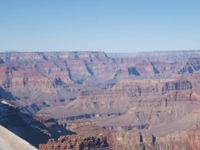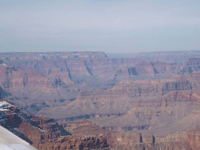| Air Quality Division: Regional Haze and Visibility |
|
Latest Developments (see below) There are three forms of visibility impairment - a reduction in one's ability to see clearly or far: urban haze, "plume blight", and regional haze. Urban haze, often referred to as "brown cloud", comes from the scattering of light due to various types of pollution from a wide range of sources found in large cities. "Plume blight" or Reasonably Attributable Visibility Impairment (RAVI) Can be a plume of pollution rising from a specific source, but it commonly refers to pollution coming from the stack or chimney of a stationary source (e.g., electrical generating station or copper smelting operation).
Regional Haze Regional Haze is defined as visibility impairment caused by the emission of air pollutants from numerous sources located over a wide geographic area. The RHR outlines the requirements for states to follow in order to address haze impairing pollutants (71 FR 60631 Best Available Retrofit Technology (BART) The RHR requires Best Available Retrofit Technology (BART) to be considered as a control measure on specific categories of major stationary sources of haze-producing pollutants in existence prior to the 1977 Clean Air Act Amendments. Most of these sources are refineries, smelters and coal-fired electrical generating units (EGUs) that emit 250 tons per year (TPY) of sulfur dioxide (SO2), oxides of nitrogen (NOX), and particulate matter (PM). Should a source be found BART-eligible, a determination of the source's contribution to visibility impairment and the resulting emission reductions from the application of BART is conducted. General information on BART is available from WRAP Arizona has completed the BART determinations for applicable sources within the state. Summaries on the BART analyses can be found in the final Regional Haze SIP. The full BART determinations can be found in Appendix D. Catalyst Paper (Snowflake) Inc. (formerly Abitibi Consolidated)
Arizona Public Service (APS) Cholla
Arizona Electric Power Cooperative (AEPCO), Inc.
Salt River Project (SRP) Coronado
APS (West Phoenix facility) and Chemical Lime Company (Nelson facility) were found to be BART eligible. ADEQ received the following analyses and determined that these facilities were not subject to BART.
Arizona Regional Haze State Implementation Plan (SIP) The RHR requires states to submit a plan under Section 308 or Section 309. States submitting Regional Haze Plans under Section 309 of the RHR are required to submit plans to address visibility impairment at Class I areas not covered by Section 309 plans. States submitting under Section 309(g) must follow the provisions of Section 308(d)(1) through (4) of the RHR. In 2010, Arizona opted out of Section 309 and will submit a plan under Section 308. The plan will address all of Arizona’s Class I areas. A Regional Haze stakeholder meeting was held on October 19, 2010, at ADEQ. The following materials were distributed at the meeting: The public comment period for the proposed plan began October 28, 2010 and ended December 2, 2010. A public hearing was held at ADEQ on December 2, 2010. The final SIP was submitted to U.S. EPA on March 2, 2011.
See Also:
Archived Documents For more information, please contact us. |

